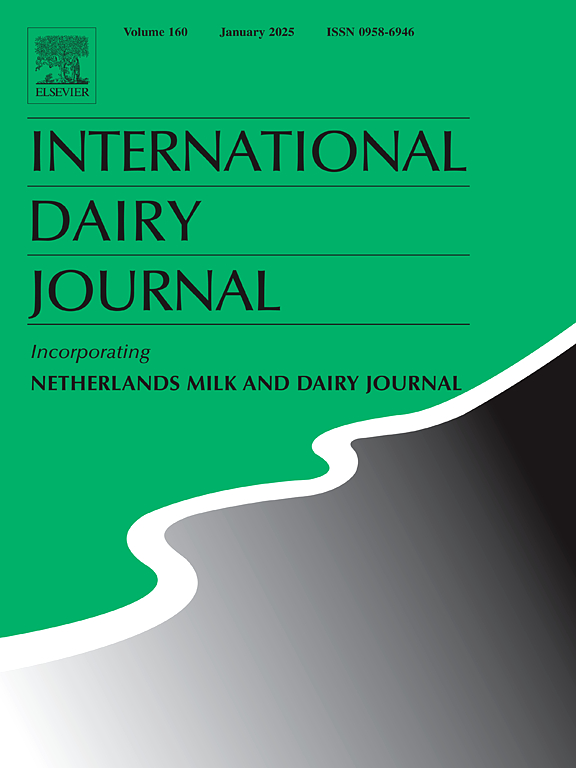Determining conditions for inactivation of multispecies biofilm cells by peracetic acid applying response surface methodology
IF 3.1
3区 农林科学
Q2 FOOD SCIENCE & TECHNOLOGY
引用次数: 0
Abstract
Biofilms can form on various surfaces and are typically associated with multiple microbial species. Particularly in the food industry, biofilms are often a source of contamination, necessitating mitigation strategies. In this study, Response Surface Methodology (RSM) was utilized to optimize conditions for the inactivation of multispecies biofilm cells, with peracetic acid (PAA) (0.05%–0.5%), treatment time (5–30 min), and temperature (25–60 °C) as independent variables. The multispecies biofilm consisted of Gram-positive and Gram-negative bacteria previously isolated from biofilms formed in the presence of raw milk. Stainless steel coupons were immersed in reconstituted whole milk inoculated with Pseudomonas fluorescens, Rahnella inusitata, Staphylococcus aureus, and Micrococcus aloeverae. Sessile cell counts of approximately 108 CFU/cm2 were obtained after 10 days of incubation at 4 °C. The response surface model exhibited a good fit, with R2 of 0.949 and adjR2 of 0.883. All independent variables had a positive effect on the inactivation of biofilm cells. The maximum inactivation achieved was approximately 7 log (CFU/cm2), with the highest values observed at 0.5% PAA, for 30 min at 60 °C. Epifluorescence microscopy revealed that many cells in the biofilm were dead or injured after treatment at the central point (PAA = 0.275%; Time = 17.5 min; Temperature = 42.5 °C). RSM helps to predict better conditions for maximum biofilm eradication and proves to be a promising approach for monitoring the inactivation of multispecies biofilm cells, which warrants further exploration.
应用响应面方法确定过乙酸灭活多物种生物膜细胞的条件
生物膜可在各种表面形成,通常与多种微生物物种有关。特别是在食品工业中,生物膜往往是污染源,因此需要采取缓解策略。本研究采用响应面方法(RSM)优化灭活多物种生物膜细胞的条件,过乙酸(PAA)(0.05%-0.5%)、处理时间(5-30 分钟)和温度(25-60 °C)为自变量。多菌种生物膜由之前从生乳中形成的生物膜中分离出的革兰氏阳性菌和革兰氏阴性菌组成。将不锈钢垫片浸入接种了荧光假单胞菌、Rahnella inusitata、金黄色葡萄球菌和阿洛维氏微球菌的重组全脂牛奶中。在 4 °C 下培养 10 天后,获得的无菌细胞数约为 108 CFU/cm2。响应面模型拟合良好,R2 为 0.949,adjR2 为 0.883。所有自变量都对生物膜细胞的灭活产生了积极影响。最大灭活率约为 7 log (CFU/cm2),最高值出现在 0.5% PAA 条件下,60 °C 下 30 分钟。荧光显微镜显示,生物膜中的许多细胞在中心点处理后死亡或受伤(PAA = 0.275%;时间 = 17.5 分钟;温度 = 42.5 °C)。RSM 有助于预测最大程度消除生物膜的更好条件,并证明是一种监测多物种生物膜细胞灭活的有前途的方法,值得进一步探索。
本文章由计算机程序翻译,如有差异,请以英文原文为准。
求助全文
约1分钟内获得全文
求助全文
来源期刊

International Dairy Journal
工程技术-食品科技
CiteScore
6.50
自引率
9.70%
发文量
200
审稿时长
49 days
期刊介绍:
The International Dairy Journal publishes significant advancements in dairy science and technology in the form of research articles and critical reviews that are of relevance to the broader international dairy community. Within this scope, research on the science and technology of milk and dairy products and the nutritional and health aspects of dairy foods are included; the journal pays particular attention to applied research and its interface with the dairy industry.
The journal''s coverage includes the following, where directly applicable to dairy science and technology:
• Chemistry and physico-chemical properties of milk constituents
• Microbiology, food safety, enzymology, biotechnology
• Processing and engineering
• Emulsion science, food structure, and texture
• Raw material quality and effect on relevant products
• Flavour and off-flavour development
• Technological functionality and applications of dairy ingredients
• Sensory and consumer sciences
• Nutrition and substantiation of human health implications of milk components or dairy products
International Dairy Journal does not publish papers related to milk production, animal health and other aspects of on-farm milk production unless there is a clear relationship to dairy technology, human health or final product quality.
 求助内容:
求助内容: 应助结果提醒方式:
应助结果提醒方式:


